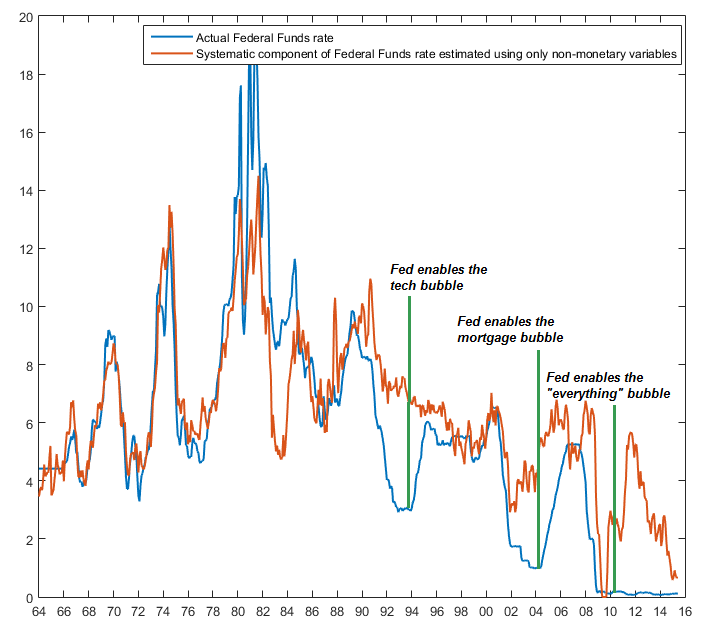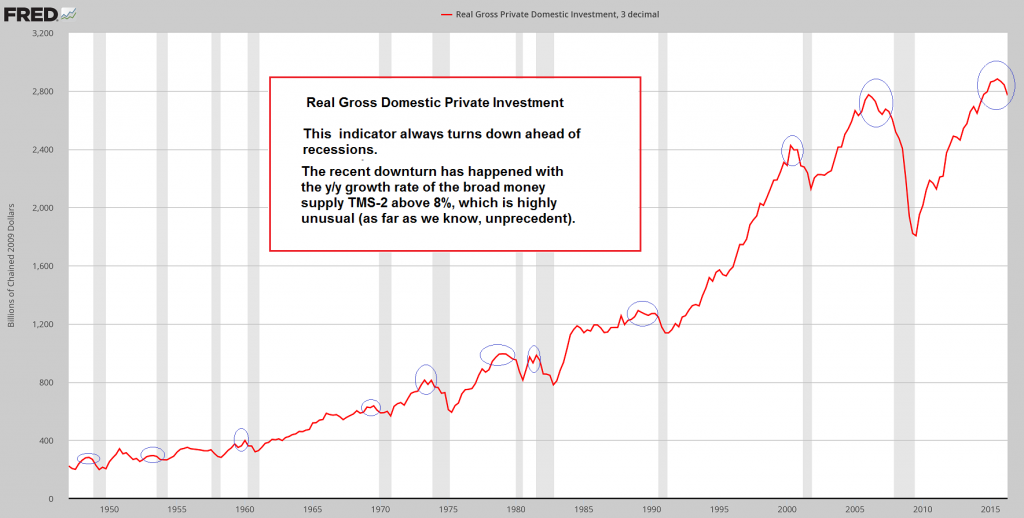John Hussman on Recent Developments
We always look forward to John Hussman’s weekly missive on the markets. Some people say that he is a “permabear”, but we don’t think that is a fair characterization. He is rightly wary of the stock market’s historically extremely high valuation and the loose monetary policy driving the surge in asset prices.

The S&P 500 Index and the NYSE advance-decline line. Most market internals weakened steadily until early February 2016, but strengthened noticeably thereafter. The a/d line is just one of many examples. A major reason for this was that market participants reassessed the likely future path of the Fed’s monetary policy – click to enlarge.
As he reminds his readers in this week’s market comment, he altered his short term outlook on the stock market when the improvement in market internals shown in the chart above asserted itself after the February 2016 low. Not only the a/d line, but a whole host of market internals improved.
The advance after the February low was broad-based and the trend in internals went counter to the negative technical evidence that had accumulated earlier.
This does of course not change the probability that the market will deliver very poor long term returns based on current valuations. This week Hussman warns that several of the trend-following components of market internals he focuses on have begun to deteriorate.
We don’t know which combination of indicators precisely he is looking at, but a number of internals have indeed begun to diverge negatively from prices lately.
FOMC Decision
In light of this week’s FOMC decision, Hussman discusses the box the Fed finds itself in. Specifically, the coincident and lagging economic aggregates which the Fed usually follows in setting its policy (output, employment and price inflation), indicate that a much tighter monetary policy would normally be considered “appropriate” at present.
Hussman refers to the combination of the above mentioned data series as the “systematic component” of monetary policy. Of course, we think there should be no central planning of interest rates and the money supply at all, but it is certainly true that the Fed’s policy is normally reactive with respect to these indicators and mirrors their combined trend. Hussman provides the following chart illustrating this:

The “systematic component” of the Federal Funds rate. As the chart shows, asset price bubbles tend to be promoted whenever administered interest rates deviate strongly from the trend in these economic variables.
The Fed has waited so long with tightening monetary policy, that it is now pondering rate hikes just as the performance of the economy has begun to deteriorate noticeably. As Hussman puts it:
As for Wednesday’s decision, two things are clear from the chart above. One is that our own estimate of the appropriate Federal Funds rate here is certainly above 1% at present. But the other is that we’ve seen significant and progressive deterioration in underlying economic conditions recently, so it’s not clear that this is a pressing moment to normalize policy, except to rein in a financial bubble that already has “market crash” written all over it. Whatever policy error the Fed might make by raising, or not raising, interest rates here pales in comparison to what activist Fed policy has already baked in the cake.
Along the lines of our recent discussions of the US economy (see “US Economy, Something is not Right” and the related update “Curious ISM Readings” for details), Hussman proceeds to show that the recent trend in economic data is not exactly much to write home about; even prominent lagging economic indicators such as employment growth don’t look particularly strong anymore.
The two charts below confirm that the economy’s performance is actually quite weak. What is surprising about this is mainly the fact that it happens in conjunction with fairly brisk credit and money supply growth. This is probably a sign that the economy’s pool of real savings is in trouble, i.e., that it can no longer support all the long term investment projects currently underway and the present level of consumption at the same time.

Real gross private domesticinvestment: this series is only updated quarterly, but it has now declined for three consecutive quarters, which is usually a fairly strong recession warning – click to enlarge.

Industrial production (red line) and non-defense capital goods orders (black line), y/y growth rate. These indicators started to weaken and eventually declined into negative territory as soon as QE3 ended – click to enlarge.
Recently “price inflation” in the form of core CPI has surged more than expected though), and wages have been in an upward trend for quite some time as well. So the Fed is indeed in a quandary. Even though an additional small rate hike of 25 basis points in the FF rate should in practice not make much difference to the economy, it would very likely have a noticeable psychological effect on asset prices.
Hussman makes a few interesting comments on rising wages and the inflation-targeting policy of central banks as well, which we will discuss in a separate post.
Conclusion
Currently no-one expects the Fed to hike in September and it probably won’t. It is definitely possible though that the FOMC statement will contain a strong hint regarding a likely rate hike in November or December, since the Fed for some reason no longer wants to surprise markets. Such an announcement could well have the same effect on the markets as an actual hike though.
This may also explain why market volatility has recently increased and why market internals have begun to deteriorate a bit. Some market participants seem to be worried that the market’s assessment regarding future Fed policy is about to change again. If that turns out to be correct, a sizable downturn in the stock market may well be triggered shortly.
